Requiem Sharks
Requiem sharks, ground sharks, blue sharks, and sharpnose sharks are the common names for the members of the Carcharhinidae family. They have 5 gill openings, the fifth behind origin of pectoral fin. Their eyes are on sides of head, with a well-developed nictitating lower eyelid. They also have sharp blade like teeth.
Members of the Carcharhinidae are found in all oceans, mostly in tropical waters. They are the largest shark family, with 12 known genera and 58 species worldwide. Small species often occur inshore while the large species often occur offshore. These fishes are strong and active swimmers. They can occur either solitary or in small school. All species are live-bearing, with young born fully developed. They feed on any animal that may present in their habitat, and some large species are known to attack human.
Members of the Carcharhinidae are found in all oceans, mostly in tropical waters. They are the largest shark family, with 12 known genera and 58 species worldwide. Small species often occur inshore while the large species often occur offshore. These fishes are strong and active swimmers. They can occur either solitary or in small school. All species are live-bearing, with young born fully developed. They feed on any animal that may present in their habitat, and some large species are known to attack human.
Scientific Name: Carcharhinus leucas (Müller & Henle, 1839)
English Name: Bull Shark, Estuary Shark, River Whaler Shark, Freshwater Whaler
Chinese Name | 鱼类中文名: 低鳍真鲨 (Dī qí zhēn shā), 公牛白眼鲛 (Gōngniú báiyǎn jiāo), 圆吻真鲨 (Yuán wěn zhēn shā), 鲨鱼 (Shāyú)
Malay Name | Nama Melayu Malaysia: Yu Bekeng, Yu Ganas, Yu Garang, Jerung Sapi
Thai Name | ชื่อสามัญภาษาไทย: ปลาฉลามหัวบาตร (Plā c̄hlām hua bart)
Local Hokkien: Sua Hu
Main Identification Features: Snout very short and broadly rounded. Eyes small. Upper teeth erect to slightly oblique, broadly triangular, serrated. Lower teeth similar but more slender. Lack interdorsal ridge. Pectoral fins large and angular. Upper caudal fin with a thin dusky posterior margin which fade with age.
Size: Maximum total length 360 cm (male) and 400.0 cm (female), commonly to 260 cm. Size at birth 55 to 81 cm and matures at 160 to 200 cm.
Habitat and Ecology: Inhabits shallow coastal and freshwater, from 1 to 152 m depth, commonly to 30 m depth. Moving between fresh and brackish water at random. Adults often found near estuaries and freshwater inflows to the sea, young enter rivers and may be found hundreds of km from the sea. Viviparpous, with a yolk-sac placenta, gives birth to litters of up to 13 young, after a gestation period of 10 to 11 months. An extremely dangerous shark, feeds primarily of bony fishes and elasmobranchs, but also other animals.
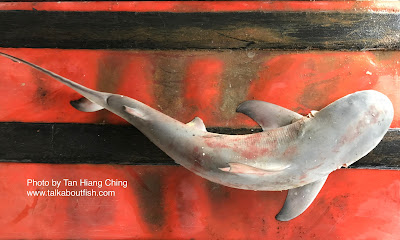

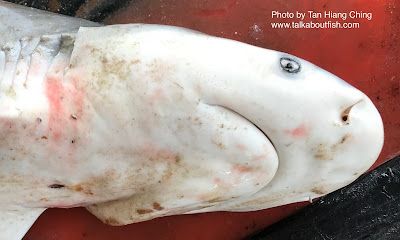
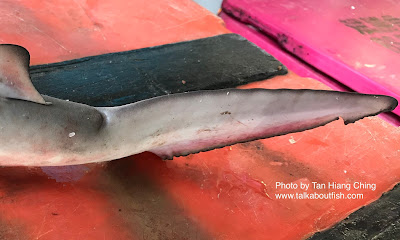
Scientific Name: Carcharhinus macloti (Müller & Henle, 1839)
English Name: Hardnose Shark
Chinese Name | 鱼类中文名: 鲨鱼 (Shāyú)
Malay Name | Nama Melayu Malaysia: Yu Pasir, Yu Jereh, Yu Muncung Keras
Thai Name | ชื่อสามัญภาษาไทย: ปลาฉลามจมูกแข็ง (Plā c̄hlām cmūk k̄hæ̆ng)
Local Hokkien: Sua Hu
Main Identification Features: Snout very hard, long and narrowly rounded or pointed. Inner margin of first dorsal fin extremely long, about 2/3 of fin base. Second dorsal fin very low, the inner margin over twice the fin height. Posterior margin of pectoral fins and ventral caudal-fin lobe with an inconspicuous white edge.
Size: Maximum total length 110 cm. Size at birth 45 to 50 cm and matures at 70 to 75 cm.
Habitat and Ecology: Inshore and offshore waters of continental and insular shelves, to 170 m depth. Feeds mainly on fishes, also on cephalopods and crustaceans.
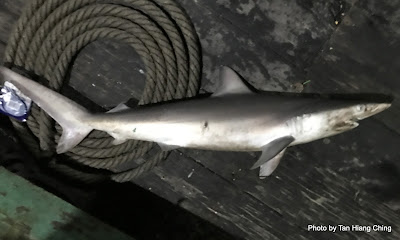
Scientific Name: Carcharhinus sorrah (Müller & Henle, 1839)
English Name: Spot-tail Shark, Sorrah Shark, School Shark
Chinese Name | 鱼类中文名: 鲨鱼 (Shāyú)
Malay Name | Nama Melayu Malaysia: Kalitan, Yu Kepak Hitam
Thai Name | ชื่อสามัญภาษาไทย: ปลาฉลามหูดำ (Plā c̄hlām h̄ū dả)
Local Hokkien: Sip Suar
Main Identification Features: Pectoral fins, second dorsal fin, and lower caudal-fin lobe with conspicuous black tips. First dorsal and upper caudal-fin lobe with black edge. Second dorsal fin low, with very elongated inner margin over twice fin height.
Size: Maximum total length to about 1.6 m, adults commonly 1.06 to 1.5 cm. Size at birth about 50 to 60 cm. Size at maturity 90 to 112 cm.
Habitat and Ecology: Inshore and offshore waters of continental and insular shelves, to at least 140 m depth. Live near the bottom during the day and near the surface at night. Juveniles prefer shallow inshore waters. Feeds on small bony fishes and cephalopods.


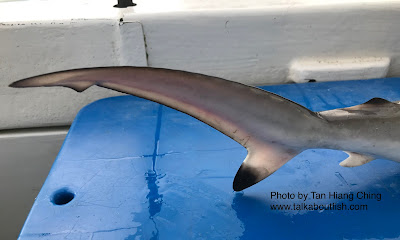
Scientific Name: Scoliodon laticaudus Müller & Henle, 1838
English Name: Spadenose Shark, Yellow Dogshark, Indian Dogshark
Chinese Name | 鱼类中文名: 尖头沙 (Jiāntóushā)
Malay Name | Nama Melayu Malaysia: Yu Jerih, Jerung, Yu Padi
Thai Name | ชื่อสามัญภาษาไทย: ปลาฉลามหัวแหลม (Plā c̄hlām h̄ạwh̄ælm)
Local Hokkien: Sua Hu
Main Identification Features: Head greatly depressed and trowel-shaped. Long snout. Pectoral fins broadly triangular, and not falcate.
Size: Maximum total length about 74 cm. Size at birth about 13 to 15 cm. Males mature at 24 to 36 cm and females at 33 to 35 cm.
Habitat and Ecology: Rocky bottom in shallow coastal waters. Feeds on small fishes, crustaceans and cephalopods.

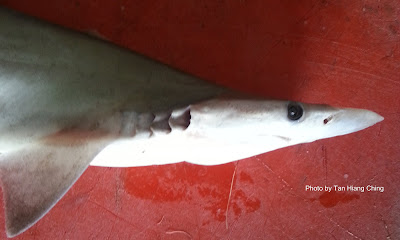


English Name: Bull Shark, Estuary Shark, River Whaler Shark, Freshwater Whaler
Chinese Name | 鱼类中文名: 低鳍真鲨 (Dī qí zhēn shā), 公牛白眼鲛 (Gōngniú báiyǎn jiāo), 圆吻真鲨 (Yuán wěn zhēn shā), 鲨鱼 (Shāyú)
Malay Name | Nama Melayu Malaysia: Yu Bekeng, Yu Ganas, Yu Garang, Jerung Sapi
Thai Name | ชื่อสามัญภาษาไทย: ปลาฉลามหัวบาตร (Plā c̄hlām hua bart)
Local Hokkien: Sua Hu
Main Identification Features: Snout very short and broadly rounded. Eyes small. Upper teeth erect to slightly oblique, broadly triangular, serrated. Lower teeth similar but more slender. Lack interdorsal ridge. Pectoral fins large and angular. Upper caudal fin with a thin dusky posterior margin which fade with age.
Size: Maximum total length 360 cm (male) and 400.0 cm (female), commonly to 260 cm. Size at birth 55 to 81 cm and matures at 160 to 200 cm.
Habitat and Ecology: Inhabits shallow coastal and freshwater, from 1 to 152 m depth, commonly to 30 m depth. Moving between fresh and brackish water at random. Adults often found near estuaries and freshwater inflows to the sea, young enter rivers and may be found hundreds of km from the sea. Viviparpous, with a yolk-sac placenta, gives birth to litters of up to 13 young, after a gestation period of 10 to 11 months. An extremely dangerous shark, feeds primarily of bony fishes and elasmobranchs, but also other animals.
Scientific Name: Carcharhinus macloti (Müller & Henle, 1839)
English Name: Hardnose Shark
Chinese Name | 鱼类中文名: 鲨鱼 (Shāyú)
Malay Name | Nama Melayu Malaysia: Yu Pasir, Yu Jereh, Yu Muncung Keras
Thai Name | ชื่อสามัญภาษาไทย: ปลาฉลามจมูกแข็ง (Plā c̄hlām cmūk k̄hæ̆ng)
Local Hokkien: Sua Hu
Main Identification Features: Snout very hard, long and narrowly rounded or pointed. Inner margin of first dorsal fin extremely long, about 2/3 of fin base. Second dorsal fin very low, the inner margin over twice the fin height. Posterior margin of pectoral fins and ventral caudal-fin lobe with an inconspicuous white edge.
Size: Maximum total length 110 cm. Size at birth 45 to 50 cm and matures at 70 to 75 cm.
Habitat and Ecology: Inshore and offshore waters of continental and insular shelves, to 170 m depth. Feeds mainly on fishes, also on cephalopods and crustaceans.
Scientific Name: Carcharhinus sorrah (Müller & Henle, 1839)
English Name: Spot-tail Shark, Sorrah Shark, School Shark
Chinese Name | 鱼类中文名: 鲨鱼 (Shāyú)
Malay Name | Nama Melayu Malaysia: Kalitan, Yu Kepak Hitam
Thai Name | ชื่อสามัญภาษาไทย: ปลาฉลามหูดำ (Plā c̄hlām h̄ū dả)
Local Hokkien: Sip Suar
Main Identification Features: Pectoral fins, second dorsal fin, and lower caudal-fin lobe with conspicuous black tips. First dorsal and upper caudal-fin lobe with black edge. Second dorsal fin low, with very elongated inner margin over twice fin height.
Size: Maximum total length to about 1.6 m, adults commonly 1.06 to 1.5 cm. Size at birth about 50 to 60 cm. Size at maturity 90 to 112 cm.
Habitat and Ecology: Inshore and offshore waters of continental and insular shelves, to at least 140 m depth. Live near the bottom during the day and near the surface at night. Juveniles prefer shallow inshore waters. Feeds on small bony fishes and cephalopods.
Scientific Name: Scoliodon laticaudus Müller & Henle, 1838
English Name: Spadenose Shark, Yellow Dogshark, Indian Dogshark
Chinese Name | 鱼类中文名: 尖头沙 (Jiāntóushā)
Malay Name | Nama Melayu Malaysia: Yu Jerih, Jerung, Yu Padi
Thai Name | ชื่อสามัญภาษาไทย: ปลาฉลามหัวแหลม (Plā c̄hlām h̄ạwh̄ælm)
Local Hokkien: Sua Hu
Main Identification Features: Head greatly depressed and trowel-shaped. Long snout. Pectoral fins broadly triangular, and not falcate.
Size: Maximum total length about 74 cm. Size at birth about 13 to 15 cm. Males mature at 24 to 36 cm and females at 33 to 35 cm.
Habitat and Ecology: Rocky bottom in shallow coastal waters. Feeds on small fishes, crustaceans and cephalopods.



